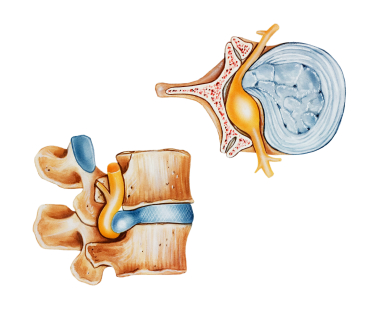Disc Herniation
If you haven’t already heard the analogy, a jelly donut is a really easy way to get the idea of a lumbar disc herniation. If you recall from previous blogs, our spine is made up of boney blocks separated by cartilage discs. These cartilage discs have a tough outer cartilage (like the dough of a donut) and a soft jelly substance in the middle (like the jelly in a donut). In very simple terms, a disc herniation is much like having a crack or tear in the dough of the donut and the jelly in the middle leaking out that crack.
Should I have Surgery for Lumbar Disc Herniation?
On occasion we encounter patients who are considering surgery for their lumbar disc herniation. This is a tough decision and should be made with careful consideration. Obviously, there are many different factors to consider. For some, surgery is an obvious choice because the symptoms are so severe and not improving. In fact, some surgeries can be necessary (rather immediately) if the disc injury is compressing the spinal cord. For most people though, surgery is one option among many.
Physiotherapy, Chiropractic or Surgery?
A 2006 study published in the journal of the American medical association investigated the benefits of surgery for lumbar disc herniation and whether or not it was superior to conservative treatment. This study was a rather large undertaking, with many study participants and lots of media attention. The results indicated that there was no added benefit to one over the other. Given the inherent risks of any surgery, it is recommended for many patients with lumbar disc herniation to consider conservative treatment first.
Treatment for disc herniation (at Burlington Sports Therapy)
At Burlington Sports Therapy, our physiotherapists and chiropractors treat lumbar disc herniation quite regularly. It is actually quite rare for any of our patients to require surgery for their lumbar disc herniation, so we’re always happy when new patients give us a call before having surgery. Depending on such factors as pain levels, previous treatments and imaging findings, a carefully constructed treatment plan will be outlined by the chiropractor or physiotherapist. The specific treatment used might include one or a combination of modalities like laser therapy, chiropractic adjustments, mobilization (which are gentle movements of the joints), interferential current (IFC) and exercise. As mentioned above, surgery is sometimes necessary for lumbar disc herniation. In these cases, consultation with a spinal surgeon may help to determine whether surgery is appropriate. Unsure what to do? We can help you find the right treatment approach for your specific situation…feel free to contact us. info@burlingtonsportstherapy.com
References
Rhee JM, Schaufele M, Abdu WA. Radiculopathy and the herniated lumbar disc. Controversies regarding pathophysiology and management. Journal of Bone & Joint Surgery 2006; 88: 2070-2080.
Unlu Z et al. Comparison of 3 physical therapy modalities for acute pain in lumbar disc herniation measured by clinical evaluation and magnetic resonance imaging. Journal of Manipulative and Physiological Therapeutics 2008; 31: 191-198.
Weinstein JN et al. Surgical vs. nonoperative treatment for lumbar disk herniation: the spine patient outcomes research trial (SPORT): a randomized trial. JAMA 2006; 296: 2441-2450.
Weinstein JN et al. Surgical vs. nonoperative treatment for lumbar disk herniation: the spine patient outcomes research trial (SPORT): observational cohort. JAMA 2006; 296: 2451-2459.









